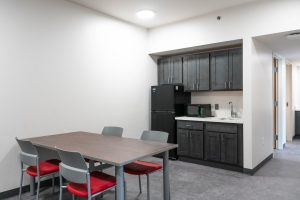Frandsen Presents on Current College Finances
December 5, 2014
Mike Frandsen, the vice president for Finance and Administration, gave students a broad overview of Oberlin’s revenue and expenses on Monday amid widespread student concern that the College isn’t doing enough to make Oberlin more affordable.
According to Frandsen, gross tuition — the sticker price that does not include financial aid — has increased by 4 percent on average over the last five years. Net student tuition — the actual amount of money collected from students after factoring in financial aid — has increased by 5.9 percent per year since 2011. Financial aid has increased by an average of 5 percent per year during the same time period.
“Eighty-two percent of our projected revenues for the next fiscal year are net student revenue, so the net amounts that will come on your behalf, either from you or others, for tuition, fees, room and board. … Student revenue drives the revenue side of the budget,” said Frandsen. “We’re tuition-dependent, and more so than our peers.”
According to Frandsen, 8 percent of the rest of the operating budget comes from the endowment. Before the 2008–2009 economic downturn took a sizable toll on Oberlin’s endowment, the rise in the endowment payout — the money Oberlin chooses to use from the endowment for its annual operating budget — typically matched the growth in financial aid. Frandsen stated that due to the recession, that was no longer the case.
“Since that endowment downturn in 2008–2009, the endowment payout leveled out. … But the stu- dent aid amount kept growing and growing and growing. So that has created a challenge not unique to Oberlin, but a challenge for colleges,” he said.
According to a graph shown by Frandsen, the percentage of American families that have a household income that’s more than three times Oberlin’s tuition fell from over 50 percent in 2002 to just under 30 percent in 2014.
“Can we sustain annual tuition rate increases? I imagine that’s part of what your question is. But at the same time can we remain competitive with compensation? You want the best professors in the classroom. They’re not free.”
According to Frandsen, about two-thirds of Oberlin’s expenses comes from salaries, wages and benefits, and 40 percent of total compensation goes to faculty. The remaining third of expenses pays for maintenance and repair costs as well as operating costs such as heating and lighting.
“For every dollar that we spend, 56 cents is going directly to instruction,” said Frandsen. “Another 15 percent goes to academic support — things like the library. Institutional support, people like me and the administration, get 17 percent.” Most of the remaining money goes to student services, according to a graph shown by Frandsen.
Frandsen said that for the last five years, revenue and expenses mostly rose together, with expenses growing slightly more than revenue. However, Frandsen predicted that Oberlin would face “pressure” in the years ahead on both the revenue and expenses sides of the equation.
Frandsen said that going forward, the finance department would focus on controlling unnecessary costs and gaining potential new, non-tuition-based revenue sources, such as renting Oberlin’s facilities out more frequently.
Several students in attendance wanted a more detailed breakdown of financial aid at Oberlin, but Frandsen said that he did not have those figures.
“At the end of the day, students as a class versus administrators as a class have competing interests,” said Zachery Crowell, College senior and student senator. “The people in finance, the people in admissions, the people in financial aid, as the 2005 Strategic Plan said, they have to lower the discount rate, they have to increase net revenue. … We want to make sure that [increasing revenue] isn’t preventing low- income and racially diverse students from coming here.”
Student Senator and chair of the transparency committee Ben Libbey was concerned about the accessibility of the College’s financial information.
“Right now our focus isn’t necessarily on finding out more raw information; our focus is on taking what we have and packaging it in a way that is easy to understand so people can inform themselves about Oberlin’s budget,” said Libbey. “I know there are a lot of people who want to learn more about the endowment, but frankly that’s up to the trustees. We also want to find out more about financial aid.”
Libbey said he felt this information session was a step in the right direction.
“I think we had great turnout,” he said. “In terms of a good, broad overview,this was very great.”
For extended coverage of College financial data, see the This Week section on page 8.

























